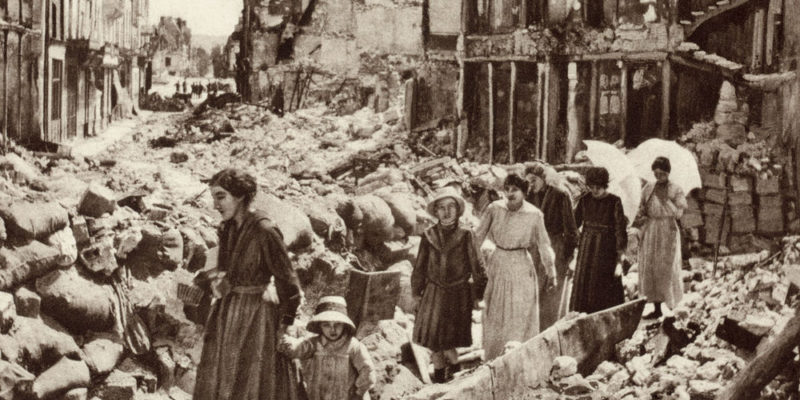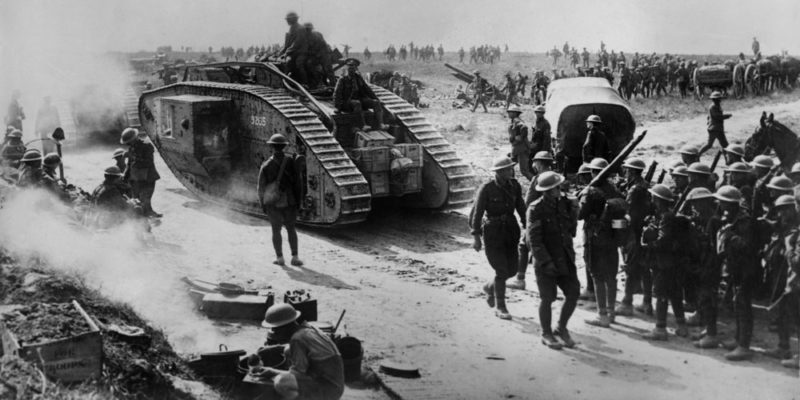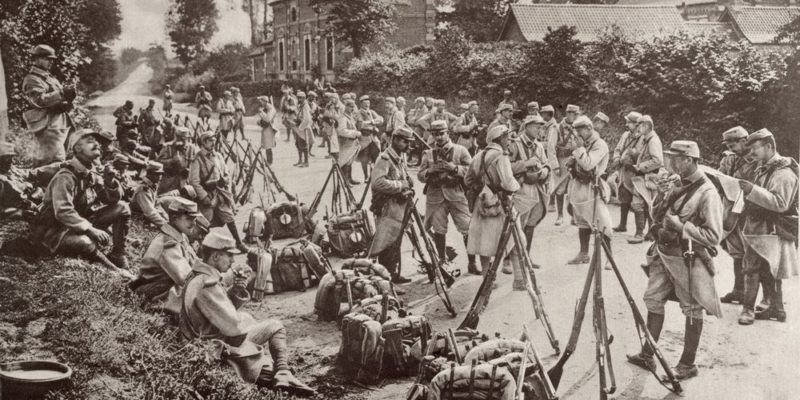We explain what the First World War was, the causes and consequences of this conflict and what its characteristics are.
What was the First World War?
World War I, also known as the Great War, was an armed conflict that involved almost every country in Europe , as well as several in Asia , Africa , and even the Americas , in four years of merciless warfare (1914-1918) .It is the fifth most costly war in history in lives , and it was extremely transcendental in the world political order, to the extent that it brought about important revolutions in various participating nations, and allowed the rise of new world powers.
The fighting forces were distinguished in two opposing multiple alliances: the Triple Alliance and the Triple Entente , of which several of the great empires of the time took part. However, throughout the conflict, adherence to one or the other side would change, as the 70 million military personnel from the different countries involved were mobilized to fight in the largest and most destructive armed conflict known at the time.
Next, and as a summary of the First World War, we present its most important characteristics.
The alliances of the First World War
 The opposing powers were grouped into two sides that were integrated as follows:
The opposing powers were grouped into two sides that were integrated as follows:
- The Triple Alliance. Made up of the so-called Central Powers: the German Empire, the Austro-Hungarian Empire and the Kingdom of Italy . The latter, however, would change sides in the first year of the conflict, and the Ottoman Empire and Bulgaria would fight instead . Other nations would join the alliance based on their patronage relationships with the Central Powers.
- The Triple Entente. Made up of the United Kingdom , France , and the Russian Empire. Italy would join them in 1915 and then Japan , Romania and the United States would join them. As the conflict grew, however, many other nations joined the alliance against the Central Powers.
Events leading to World War I
The Great War took place from 1914 to 1918. Its starting point is considered to be the assassination of Archduke Franz Ferdinand of Austria , heir to the throne of the Empire, by a young Serbian nationalist in Sarajevo. This triggered a diplomatic conflict that very quickly turned to armed conflict, as Austria-Hungary advanced on the Kingdom of Serbia and numerous previous alliances were successively invoked.
Cost in lives of the First World War
 It is estimated that some nine million military combatants lost their lives throughout the four years of conflict, as well as seven million civilian citizens .
It is estimated that some nine million military combatants lost their lives throughout the four years of conflict, as well as seven million civilian citizens .
Causes of the First World War
The causes of this conflict are directly related to the distribution of the world by European imperialism , whose colonization of Africa and Asia provided the conditions for rapid economic and industrial development, but uneven among themselves. While England and France monopolized industrial development, other powers resented and revived the grudges of past conflicts.If to this is added the rise of European nationalism during the 19th century, the growth of arms investment during the previous years and the system of alliances that governed relations between the various blocs of countries , it is understood that imperialist Europe operated as a time bomb.
Fronts of the First World War
 The Great War occurred simultaneously on several fronts:
The Great War occurred simultaneously on several fronts:
- Western front. The one that would pit France and Great Britain against Germany , essentially, after the latter had invaded Belgium and Luxembourg.
- Eastern front. In which Germany and the Austro-Hungarian Empire fought against the troops of the Russian Empire. Romania will temporarily join this front.
- Balkan front. Where they would fight the Austro-Hungarian Empire and then the Ottoman Empire and Bulgaria, against Serbia, Montenegro and Greece .
- Middle East Front. Which consisted of the confrontation of mostly British troops in their attempt to penetrate the Ottoman Empire and create a corridor to Russia. Palestine would join this front in 1916.
- African front. The British and French forces in Africa attacked the German colonies, creating a climate that would take advantage of South Africa to join the conflict and also take over South West Africa in 1915.
New technologies of the First World War
 The Great War was the scene for the use of two important military technologies : the tank and toxic or poisonous gases . In conflicts characterized above all by large contingents of infantry, the bombardment with chemical substances was lethal and left numerous sequels among the survivors.
The Great War was the scene for the use of two important military technologies : the tank and toxic or poisonous gases . In conflicts characterized above all by large contingents of infantry, the bombardment with chemical substances was lethal and left numerous sequels among the survivors.
Revolutions of the First World War

- Russia. The Russian Empire fell in 1917 and came out of the war, since the Bolshevik Revolution was already taking place. Czarism came to an end and the first truly socialist country in history was erected: the Union of Soviet Socialist Republics.
- Germany. The fall of the German Reich, as a result of the end of the war and the workers' revolution that forced the Kaiser to flee, gave way to the German Republic in a climate of economic and political depression.
- Turkey. The Ottoman Empire, weakened by its participation in the war, yielded to the Arab revolution that took place within it and became the Republic of Turkey, also allowing the creation of other countries such as Syria, Iraq, Palestine, Israel and the region. of Hijaz.
- Poland. The Polish state returned to exist as an independent nation, taking its territory from the German and Russian Empires.
- Austria and Hungary. The Austro-Hungarian Empire also came to an end in the Great War, breaking up into Austria and Hungary.
- The Balkans. The kingdom of Serbia became a multi-ethnic nation: the Kingdom of Yugoslavia, and along with it Czechoslovakia was also born.
Treaty of Versailles
 The treaty that ended the Great War was the "Treaty of Versailles", signed in France in 1919 by more than 50 countries . In it, the defeated were subjected to strict conditions of military and political supervision, prohibition of a national army, withdrawal from their African colonies and numerous debts to pay. The harshness of these conditions and the humiliation felt by the Germans would be the breeding ground for the rise of Nazism a decade later.
The treaty that ended the Great War was the "Treaty of Versailles", signed in France in 1919 by more than 50 countries . In it, the defeated were subjected to strict conditions of military and political supervision, prohibition of a national army, withdrawal from their African colonies and numerous debts to pay. The harshness of these conditions and the humiliation felt by the Germans would be the breeding ground for the rise of Nazism a decade later.
Christmas at war
 A famous episode of the Great War took place during the trench warfare of 1914, when soldiers from the German and French sides, facing each other on Christmas Eve, fraternized and agreed to a ceasefire to celebrate Christmas .
A famous episode of the Great War took place during the trench warfare of 1914, when soldiers from the German and French sides, facing each other on Christmas Eve, fraternized and agreed to a ceasefire to celebrate Christmas .
Colonies in World War I
The Great War was famous for having forced the participation of European colonies in Africa and Asia, so that in many cases the war saw the presence of Indian , Canadian, Australian and New Zealand soldiers in the British army, as well as Africans in the British armies. Belgian and French.The above content published at Collaborative Research Group is for informational and educational purposes only and has been developed by referring reliable sources and recommendations from experts. We do not have any contact with official entities nor do we intend to replace the information that they emit.
Passionate about understanding and contributing to a world that does not stop changing. New forms of Work, Sustainability and Technology. For many years he has worked as a creative for large international companies. He has a Ph.D. in information technology and he has been doing quantitative research in the interdisciplinary areas of information systems, cyber security, data analytics and artificial intelligence. He continue to look for creative solutions through technology to help companies to be more humane and sustainable..
Leave a reply
Your email address will not be published. Required fields are marked *Recent post

Sport: What Is It, Types, Risks, Features, Characteristics and Examples
September 23, 2021

Dogs: Emergence, Features, Characteristics, Feeding and Breeds
September 24, 2021

Story: Definition, Elements, Structure, Features and Characteristics
September 24, 2021

Essay: Definition, Structure, Features, Characteristics, How to Do It
September 24, 2021
